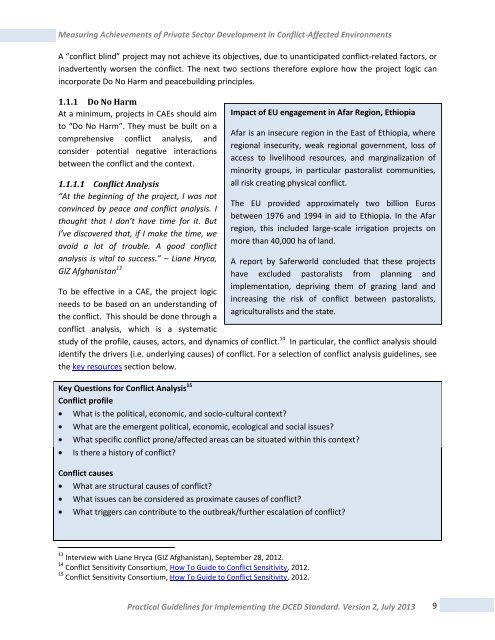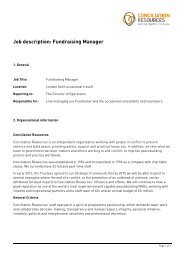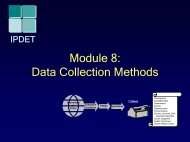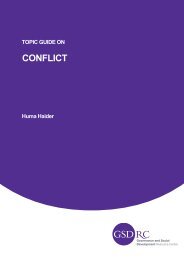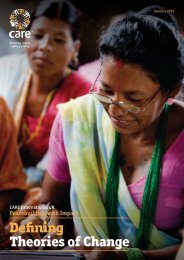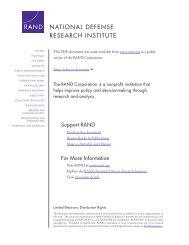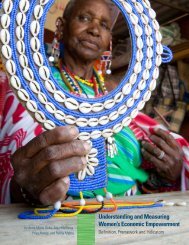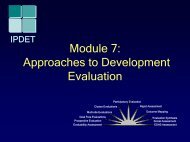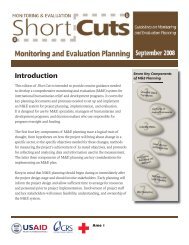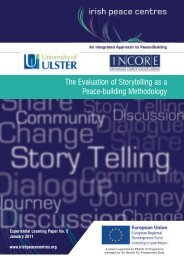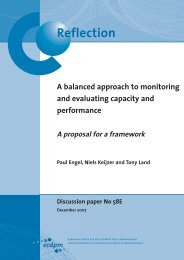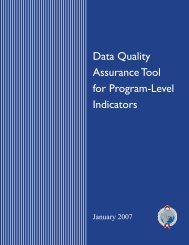Measuring Achievements of Private Sector Development in ... - DCED
Measuring Achievements of Private Sector Development in ... - DCED
Measuring Achievements of Private Sector Development in ... - DCED
Create successful ePaper yourself
Turn your PDF publications into a flip-book with our unique Google optimized e-Paper software.
<strong>Measur<strong>in</strong>g</strong> <strong>Achievements</strong> <strong>of</strong> <strong>Private</strong> <strong>Sector</strong> <strong>Development</strong> <strong>in</strong> Conflict-Affected Environments<br />
A “conflict bl<strong>in</strong>d” project may not achieve its objectives, due to unanticipated conflict-related factors, or<br />
<strong>in</strong>advertently worsen the conflict. The next two sections therefore explore how the project logic can<br />
<strong>in</strong>corporate Do No Harm and peacebuild<strong>in</strong>g pr<strong>in</strong>ciples.<br />
1.1.1 Do No Harm<br />
At a m<strong>in</strong>imum, projects <strong>in</strong> CAEs should aim<br />
to “Do No Harm”. They must be built on a<br />
comprehensive conflict analysis, and<br />
consider potential negative <strong>in</strong>teractions<br />
between the conflict and the context.<br />
1.1.1.1 Conflict Analysis<br />
“At the beg<strong>in</strong>n<strong>in</strong>g <strong>of</strong> the project, I was not<br />
conv<strong>in</strong>ced by peace and conflict analysis. I<br />
thought that I don’t have time for it. But<br />
I’ve discovered that, if I make the time, we<br />
avoid a lot <strong>of</strong> trouble. A good conflict<br />
analysis is vital to success.” – Liane Hryca,<br />
GIZ Afghanistan 13<br />
To be effective <strong>in</strong> a CAE, the project logic<br />
needs to be based on an understand<strong>in</strong>g <strong>of</strong><br />
the conflict. This should be done through a<br />
conflict analysis, which is a systematic<br />
study <strong>of</strong> the pr<strong>of</strong>ile, causes, actors, and dynamics <strong>of</strong> conflict. 14<br />
In particular, the conflict analysis should<br />
identify the drivers (i.e. underly<strong>in</strong>g causes) <strong>of</strong> conflict. For a selection <strong>of</strong> conflict analysis guidel<strong>in</strong>es, see<br />
the key resources section below.<br />
Key Questions for Conflict Analysis 15<br />
Conflict pr<strong>of</strong>ile<br />
What is the political, economic, and socio-cultural context<br />
What are the emergent political, economic, ecological and social issues<br />
What specific conflict prone/affected areas can be situated with<strong>in</strong> this context<br />
Is there a history <strong>of</strong> conflict<br />
Conflict causes<br />
What are structural causes <strong>of</strong> conflict<br />
What issues can be considered as proximate causes <strong>of</strong> conflict<br />
Impact <strong>of</strong> EU engagement <strong>in</strong> Afar Region, Ethiopia<br />
Afar is an <strong>in</strong>secure region <strong>in</strong> the East <strong>of</strong> Ethiopia, where<br />
regional <strong>in</strong>security, weak regional government, loss <strong>of</strong><br />
access to livelihood resources, and marg<strong>in</strong>alization <strong>of</strong><br />
m<strong>in</strong>ority groups, <strong>in</strong> particular pastoralist communities,<br />
all risk creat<strong>in</strong>g physical conflict.<br />
The EU provided approximately two billion Euros<br />
between 1976 and 1994 <strong>in</strong> aid to Ethiopia. In the Afar<br />
region, this <strong>in</strong>cluded large-scale irrigation projects on<br />
more than 40,000 ha <strong>of</strong> land.<br />
A report by Saferworld concluded that these projects<br />
have excluded pastoralists from plann<strong>in</strong>g and<br />
implementation, depriv<strong>in</strong>g them <strong>of</strong> graz<strong>in</strong>g land and<br />
<strong>in</strong>creas<strong>in</strong>g the risk <strong>of</strong> conflict between pastoralists,<br />
agriculturalists and the state.<br />
What triggers can contribute to the outbreak/further escalation <strong>of</strong> conflict<br />
13 Interview with Liane Hryca (GIZ Afghanistan), September 28, 2012.<br />
14 Conflict Sensitivity Consortium, How To Guide to Conflict Sensitivity, 2012.<br />
15 Conflict Sensitivity Consortium, How To Guide to Conflict Sensitivity, 2012.<br />
Practical Guidel<strong>in</strong>es for Implement<strong>in</strong>g the <strong>DCED</strong> Standard. Version 2, July 2013<br />
9


